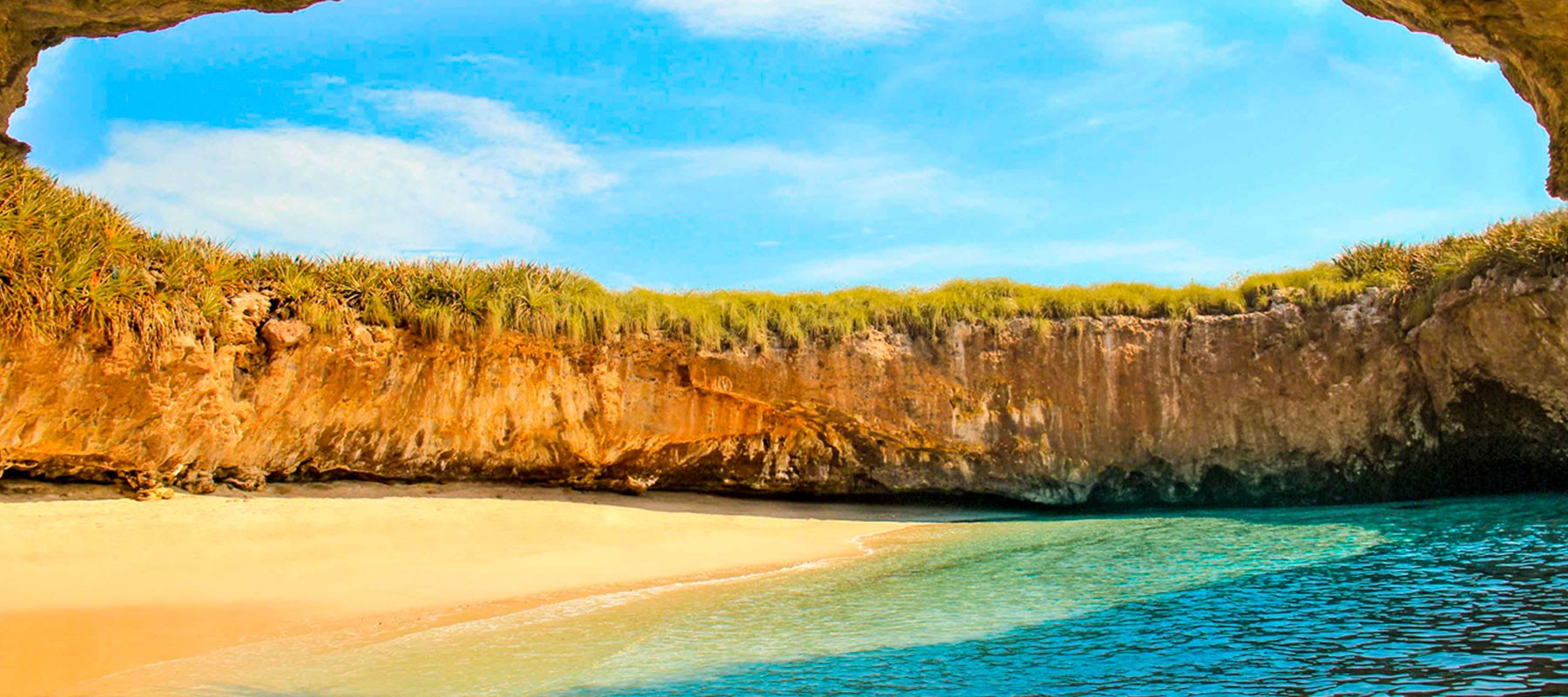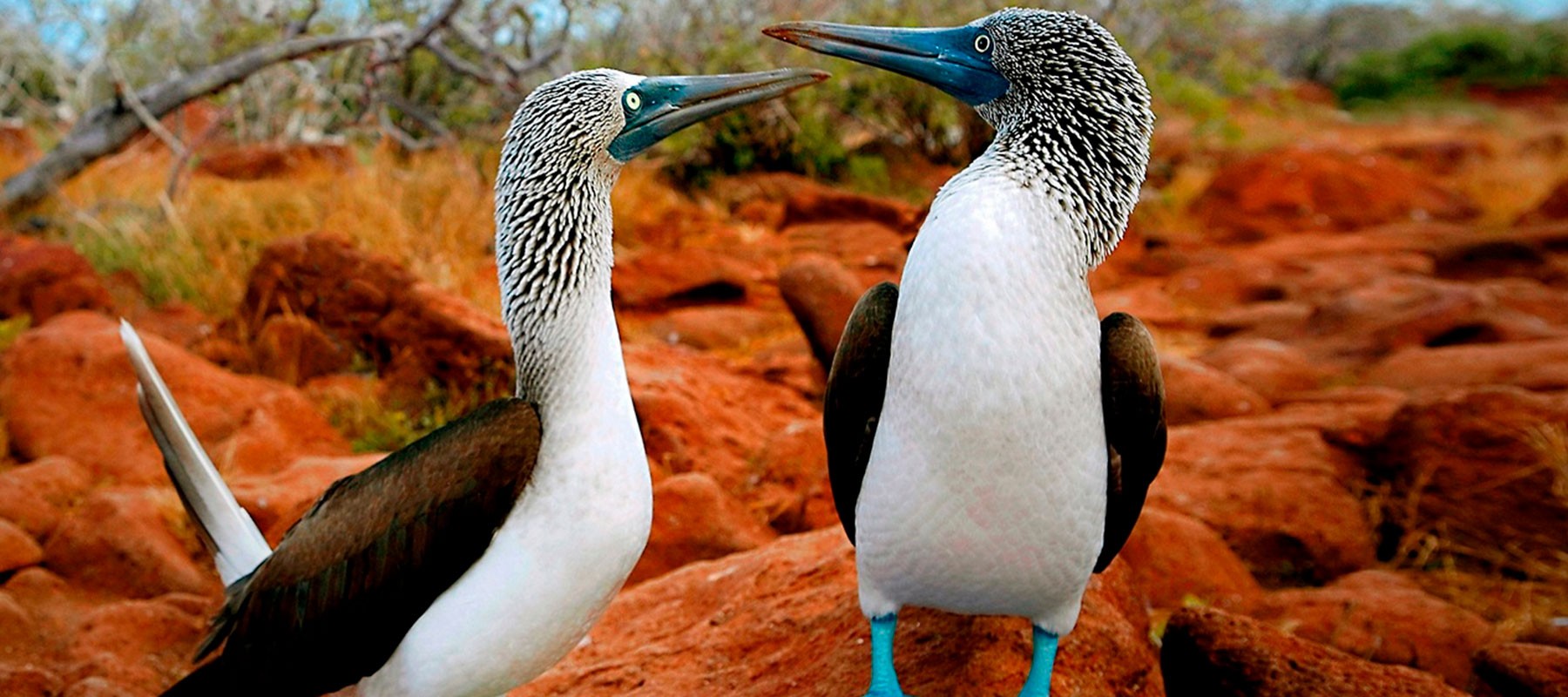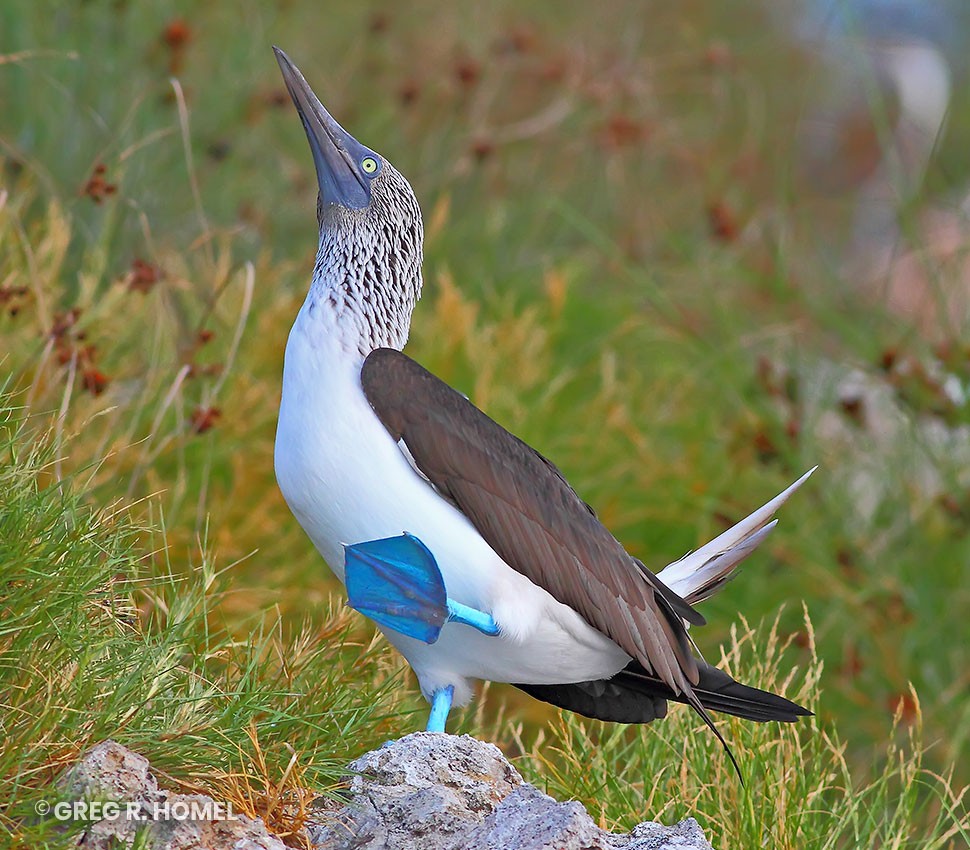Marietas Islands AKA “THE MEXICAN GALAPAGOS ISLANDS”
Birds to Watch: 108
Location: Marietas Islands » Nayarit
GPS: 20.69889 / -105.58507 ALT: 2611.5 ft
Bird Sanctuary, National Park and UNESCO Marine Reserve in Bahia Banderas, including Punta De Mita, Nayarit
Join Birding in Mexico twice a week to seek out up to 30+ species of seabirds, 10 species of marine mammals—including a very healthy population of wintering Humpbacked Whales and Killer Whales—Kemp’s Ridley Sea turtles, Manta Rays and more in season by visiting Nayarit’s “Mexican Galapagos Islands”—at UNESCO’s Marietas Islands National Park, Marine Reserve and Seabird Sanctuary!
– State of the Republic: Nayarit
– Location: Islas Marietas National Park and Marine Reserve
– Popularity of this tour: This excursion is very popular and provides a unique opportunity for close-up views of two species of boobies, frigatebirds, whales, dolphins, sea turtles and more at an uninhabited archipelago close to Puerto Vallarta. Special options can now be arranged to land on one of the islands to follow Mexican biologists along the 305 m / 1000’ trail for once in a lifetime views of nesting seabirds, endemic plants and several species of terrestrial reptiles! Please inquire for pricing and availability
– Address: The Embarcadero de Punta Mita (boat harbor) is located at Ave El Anclote 20, Punta de Mita, Nayarit.
Location & Full Tour Description:
Though long known to local fishermen and other mariners dating at least as far back as the time of the Spanish Conquistadores, in the1960s Jacques Cousteau officially put the Islas Marietas (Marietas Islands) “on the world map” for the ecotourists, birders and adventure seekers!
After watching his television production, “The Undersea World of Jacques Cousteau,” awe-struck travelers of the time witnessed the incredible beauty, accessibility and vulnerability of the “Mexican Galapagos Islands” located just off the coast of Nayarit, and have been visiting them ever since.
Replete with nesting colonies of Magnificent Frigatebirds, Blue-footed and Brown boobies, Bridled Terns, Brown Noddies, and more—the Marietas Islands comprise a cluster of uninhabited volcanic islands located in the northern extremity of Banderas Bay, just 7.9 kms / 4.26 nautical miles / 20-minutes offshore from Punta de Mita, and are now easily accessible by boat.
They lie in the State of Nayarit and were declared a National Park and Seabird Sanctuary in 1975, covering a surface area of 53 square kilometers that is dominated by two main islands—Isla Larga (900 m x 400 m) or Long Island and Isla Redonda (1000 x 500 m) or Round Island, in addition to several satellite islets.
In recognition of their unique natural and cultural values, The Islas Marietas have been afforded the triple distinction of being declared a National Park, a UNESCO MAB Biosphere Reserve and RAMSAR site!
Most of the archipelago is completely protected from landings, and has been since 2016, for the benefit of its sensitive nesting colonies of boobies, frigates and other seabirds, and in an effort to keep people from trampling the native vegetation or negatively impacting several endemic invertebrates and reptiles—including several species of lizards and two snakes!
There are two exceptions to the “No Landings Rule” and they are:
a. Playa Escondida—“Hidden Beach,” Redonda Island:
Sometimes colloquially known as “Lovers Beach,” visits to this scenic local is limited to 116 people per day and not productive for birding. BIM does not make an effort to visit this spot, as it is usually packed with general tourists and it is simply impossible to view birds from the vantage point afforded.
b. Isla Larga Interpretive Trail, Isla Larga:
Now this one is another story altogether!
Much to the delight of intrepid birders like ourselves, the National Commission of Natural Protected Areas (CONANP) has opened a new interpretive trail at the northwestern end of Isla Larga, starting at Playa La Nopalera (Prickly Pear Cactus Beach), as a new sustainable tourism option at the National Park.
Fortunate BIM participants who opt for this special excursion will follow certified Mexican Biologists along a 305 m / 1000’ interpretative path to ethically obtain once in a lifetime encounters with nesting seabirds, several reptiles—ranging from endemic subspecies of Mexican Spiny-tailed and Green iguanas, to Many-lined Whiptail, Night Snake and the Neotropical Whipsnake, etc.—in addition to unique species and subspecies of plants comprising 25 distinct forms in 12 families—at point blank range. Don’t forget your cameras!
BIM now offers two options at the Islas Marietas:
a. Our Boating for Boobies Excursion: Prioritizing pelagic seabirds, whales and visits to the coasts of several islands for close-up views of boobies, frigates, noddies, terns and cormorants, etc.
b Special Expeditionary Excursion: Prioritizing a landing on Isla Larga and close-up viewing and bird photography from the new Isla Larga Interpretive Trail.
Whether opting for our Boating for Boobies or Special Expeditionary Excursion, BIM utilizes “small” but stable boats (usually around 35’ or so) piloted by experienced, licensed captains and crew, that can ethically approach seabirds and marine mammals, the former sometimes to within mere meters, for excellent views and photographic opportunities—so be sure to bring your cameras whichever expedition you choose!
Please inquire for dates and availability and state your preference for either our Boating or Special Expeditionary Excursion
Birding in Mexico can bring you there today!.
1-Private Pickup at 6:00a.m. sharp!
6:00a.m.
Private pickup at your hotel or an appointed nearby location, followed by participant introductions and a description of your tour’s logistics, replete with a display map so you can get your bearings.
*Upon pick-up we will provide, free of charge, motion countering medication to those who request it. We highly recommend you take advantage of this protocol in order to get the most out of your excursion, free from nausea, in the event rough conditions develop while we are on the water.
Typically we offer non-drowsy Dramamine, Bonine or Meclizine, which become fully effective within 60-minutes—the positive effects of which last for approximately 6-12 hours, more than enough to cover you for our half day outings.
If you do not take the medication and become seasick, it will be too late and there is no cure other than, yes, you guessed it….
*All outings depart in the early morning, a time when sea conditions are calmest. Very rough conditions, high sea advisories or storms cancel the trip, and you will receive either a refund or option to reschedule.
*Timings are approximate. Please be punctual. Casual window birding en route between Puerto Vallarta and Embarcadero Punta de Mita. We may vary the order of islands visited during this itinerary, depending on seasonality, tips from our captain or regional birding friends and exciting nearby birding discoveries.
2-Driving between Vallarta and the Embarcadero de Punta Mita (boat harbor) to access today’s Birding in Mexico Hotspot—Marietas Islands National Park (41.8 kms / 44 mins):
6:15a.m.-7:15 a.m.
We drive north on Carretera 200 to cross the Rio Ameca bridge, and enter Nayarit from the State of Jalisco.
Technically, Nayarit is 1-hour earlier than Jalisco, but the region we are traveling in remains on Puerto Vallarta Time for convenience, so there is no need to adjust your clocks.
The primary habitat traversed, once we leave the urban extremities of Bucerias, a satellite town of Nueva Vallarta—is Sinaloan Thorn Forest.
We will have a comfort stop at the Pemex located about 5-kilometers from the boat harbor, as it has clean restrooms. The boat harbor has restrooms too but they are not as high a standard as the one at Pemex, hence the logic of stopping there ahead of our arrival.
Watch for endemic Rufous-bellied Chachalacas crossing the highway, and Gray Hawks perched on the roadside power lines during these last few kilometers if the lighting permits. If we miss them during our approach to the Embarcadero, we will make an effort to sight them on our way back to Puerto Vallarta, after our visit to the islands.
3-Arrival at Embarcadero Punta de Mita:
7:15am
Without haste, we arrive at Embarcadero de Punta Mita at sunup to board our very nice, stable, canopied (collapsable) boat.
Please note that you will usually be boarding the boat impromptu, from the bow, with assistance from our able bodied crew.
*For your own safety and that of your valuables (including your binoculars and camera gear) please hand all carry-on equipment to our friendly crew before boarding. They will carefully hand it back to you once you’re safely aboard the watercraft.
*There have been rare instances when overconfident individuals refused assistance and have fallen into the water while paying more attention to their gear than themselves, and both got drenched—so please accept assistance!
*Most Boats have clean but simple restrooms, for use in a pinch.
4-The Boating Expedition Begins and Breakfast Snacks are distributed:
7:15a.m.-11:00a.m.
Complimentary breakfast snacks will be provided once aboard to boost your energy levels before setting out to explore the islands.
Usually our “continental breakfast” consists of yogurt, fruit, juices, granola bars and other nutritious options. Cold, bottled fresh water and a selection of soft drinks—including diet alternatives—are also readily on tap. Supplies are limited.
Throughout the approximately 3-4 hour excursion, fresh water, snacks and soft drinks will be available.
*Supplies are limited, and we apologize in the event that your first preference is unavailable.
Star Seabirds regularly encountered: Laughing, Franklin’s (spring and fall), and Heermann’s (mostly winter) gulls, Brown Noddy (summer), Bridled and Least terns (both summer), Common (winter and migration), Royal and Elegant (spring mostly) terns; Red-billed Tropicbird (uncommon); Magnificent Frigatebird; Blue-footed and Brown boobies; Brandt’s Cormorant; Brown Pelican, etc.
2. Occasional Seabird Surprises: Craveri’s Murrelet; Black and Least storm-petrels; Pink-footed, Sooty, Galapagos and Black-vented shearwaters; Red-footed Booby; Double-crested Cormorant; Pomarine and Parasitic jaegers, etc.
3. Expected Shorebirds and Long-legged Waders on the islands: American Oystercatcher, Whimbrel, Spotted Sandpiper, Wandering Tattler, Yellow-crowned Night-Heron, and Snowy Egret, etc.
3. Occasional Shorebird and Long-legged Wader Surprises: Surfbird, Red-necked and Red phalaropes (both usually in flocks on the water), Wandering Tattler, Great Blue Heron, etc.
5. Other expected species or specialties: Zone-tailed Hawk (one pair has nested on the islands for years), Black and Turkey vultures, Belted Kingfisher (winter) and Gray-breasted Martin (nests in spring and summer), etc.
For a full list of birds recorded on the Islas Marietas please press here
5-Return to Embarcadero Punta de Mita:
11:00am
With seas and temperatures usually rising by mid day, we will return to Punta de Mita for a comfort stop, likely at the Pemex we stopped at this morning, or at our beachside restaurant if a restroom is available, followed by lunch.
6-Lunch on the beach at either Punta de Mita or Boca de Tomates
11:00a.m.-12:30p.m.
We compile our exciting checklist over a fresh seafood lunch on the beach. What can be better than that?
*If we opt for lunch at Boca de Tomates please allow an extra 45 minutes for the drive.
*Those who do not prefer seafood or have seafood allergies, rest assured there will be many of the usual Mexican menu options to choose from.
7-Bonus Birding Opportunities:
12:30p.m.-1:30p.m.
If time remains we may take advantage of some exciting bonus birding opportunities, particularly in the vicinity of Punta de Mita, to look for Gray and Zone-tailed hawks, and Rufous-bellied Chachalacas before heading back to Puerto Vallarta.
If we lunch at Boca Tomates we will do some light birding at the estuary of the Rio Ameca after lunch to check out the flurries of gulls, terns, pelicans and shorebirds that often prevail there, etc.
8-Repatriation to your Hotel, Pickup Point or Home:
2:30p.m.
Upon completion of todays Birding in Mexico adventure, each participant will be cordially returned to their original pickup point, with pleasure, and it is our sincere hope that you’ll return to that point very pleased and richer for today’s Birding in Mexico experience.
Bird Watch List
** The number of birds per trip may change
To better prepare for the adventure awaiting you, please study the following lists, stratified according to habitats and seasonality:
Star Seabirds regularly encountered: Laughing, Franklin’s (spring and fall), Heermann’s (mostly winter), Brown Noddy (summer), Bridled and Least terns (both summer), Common (winter and migration), Royal and Elegant (spring mostly) terns; Red-billed Tropicbird (uncommon); Magnificent Frigatebird; Blue-footed and Brown boobies; Brandt’s Cormorant; Brown Pelican, etc.
2. Occasional Seabird Surprises: Craveri’s Murrelet; Black and Least storm-petrels; Pink-footed, Sooty, Galapagos and Black-vented shearwaters; Red-footed Booby; Double-crested Cormorant; Pomarine and Parasitic jaegers, etc.
3. Expected Shorebirds and Long-legged Waders: American Oystercatcher, Whimbrel, Spotted Sandpiper, Wandering Tattler, Yellow-crowned Night-Heron, and Snowy Egret, etc.
3. Occasional Shorebird and Long-legged Wader Surprises: Surfbird, Red-necked and Red phalaropes, Wandering Tattler, Great Blue Heron, etc.
5. Other expected species of specialties: Zone-tailed Hawk, Black and Turkey vultures, Belted Kingfisher and Gray-breasted Martins, etc.
Please click on the following links to obtain a free, up to date, printable eBird lists for all the species recorded at PN Islas Marietas, Playa La Lancha and Punta de Mita:
1. PN Islas Marietas (108 Species)—https://ebird.org/printableList?regionCode=L221516&yr=all&m=
2. Playa La Lancha (139 Species)—https://ebird.org/printableList?regionCode=L2701302&yr=all&m=
3. Punta de Mita (280 Species)— https://ebird.org/printableList?regionCode=L390901&yr=all&m=
Recommended footwear for today’s excursion?
All-terrain shoes with ankle support are generally recommended on any BIM outing; tennis shoes are also acceptable on this one especially, since we will be on a boat for the majority of most outings. Make sure your shoes have rubber tread to avoid slippage while on deck, in case the seas get choppy.
If opting for the Special Expeditionary Excursion, please wear all-terrain footwear with ankle support to protect your feet from cactus spines and the jagged substrate prevailing on Isla Larga.
What kind and Color of Clothes should I Wear?
Generally we recommend lightweight clothing—especially light weight slacks—with neutral or earth tone colors (with recommendations against white or bright colors), however on this trip you can feel free to wear whatever colors you prefer, if opting for the Boating for Boobies option.
Please also don a hat or cap with a visor or brim to avoid glare, water reflections and sunburn.
If opting for the Special Expeditionary Option: Lightweight clothing—especially light weight slacks—with neutral or earth tone colors (no bright colors or whites please, as they may alert the area’s shy, sharp-eyed birds to our presence, who they may fly away prematurely without giving us reasonably close or prolonged looks, which would be a shame). Short sleeve shirts are fine.
Please also don a hat or cap with a visor or brim (again, no bright colors or whites), to avoid glare, water reflections and sunburn.
We discourage your wearing of shorts, skirts, bathing attire, or cutoff shirts that expose the mid-rift while on hikes or other outings due to the possible presence of biting insects and to avoid injuries if you stumble.
Weather—especially during the summer Monsoon season—is variable and so are sea conditions, but BIM meticulously plans all ocean-going outings to depart during the early morning hours, a time when seas are calm and solar radiation is moderate.
Tropical weather is unpredictable at best, however, so be prepared for any contingency, knowing that at any time of year the weather can turn surprisingly wicked—even at sea. Please carry a light duty windbreaker and a fleece to provide comfort during a sudden downpour or during the mid-winter months. Better safe than sorry!
Insect Repellent?
Generally unnecessary on this trip, except possibly when having lunch in a palapa-style beach restaurant… though at mid-day biting insects are few and far between.
The islands themselves are fairly free of mosquitos but deer flies may bite exposed skin if given the opportunity, so have your repellent at the ready and don’t wear shorts.
If you do carry repellent, we recommend a repellent that is sprayable via a non-aerosol propellent, since the pump style repellents may leak inside your daypack, potentially ruining your food, camera gear, or other often expensive equipment carried. Roll-on-style repellents do not efficiently cover your skin’s surface, nor your pant cuffs or socks, so you are discouraged from using them in favor of a propelled spray.
Bring your Camera Gear and Binoculars
It is assumed you have your own binoculars, as this is requisite to fully enjoy our outings!
If you are also an avid bird and / or wildlife photographer, BIM offers select Bird Photography Expeditions with world renowned photographer, writer, lecturer and bird tour leader Greg R. Homel, throughout Mexico… and the world, for that matter.
Please inquire if you are interested in learning more about our bird and wildlife photography-oriented expeditions, or take a look at our website.
Our day trips—unless otherwise specified as bird photography-centric—are focused on birding specifically, and photography as an exciting sidebar.
It goes without saying that where this excursion is concerned, once in a lifetime opportunities to photograph boobies, other seabirds, and even Zone-tailed Hawks and both Turkey and Black vultures exist! So bring your camera if you have one!
Regardless of the venue, all tour participants should consider themselves encouraged to bring their cameras and practice this enjoyable pastime during any excursion.
Recommended equipment should include digital cameras with telephoto lenses equal to the equivalent of at least 400 mm or greater (in 35 mm terms) for your bird photography efforts to be worthwhile in the first place. Bird photography tours aside, tripods are not recommended, since it’s reasonable to assume they may interfere with other participants’ freedom of movement and safety while on the boat.
Most modern lenses and many of today’s cameras are equipped with motion countering technology, anyway, making a tripod unnecessary under the conditions we will be operating within.
Please don’t forget to bring extra batteries and memory cards specific to your camera brand, as well.
Lens tissue should also be considered requisite to keep your lenses clean or to wipe incidental water or sea spray off of their (and your binoculars’) objective elements, as environmental conditions are unpredictable in the often wild regions we will be visiting. If you do not have “lens cleaning tissues,” don’t fret—in a pinch normal, one ply, unscented, napkins or toilet paper will work just as well as expensive lens tissue.
*Please inquire about loaner binoculars if you or one of your party does not have binoculars but would like to partake in this excursion. We may have one or two available, free of charge, to lend you. Apologies in advance if the loan binoculars are already claimed or unavailable for this tour.
What is this Expedition’s Level of Physical Difficulty?
Walking conditions on this excursion are EASY on the boat to MODERATE on Isla Larga, which is composed of jagged lava 60,000 years old, though the trail is well maintained.
Visitors on this lovely excursion will generally encounter easy walking conditions, though sea conditions may make footing more challenging while aboard the boat, despite the fact that the islands provide shelter from the swells.
You should be prepared for any contingency with good cheer and a spirit of adventure, while being aware that if you have to answer the call of nature the boats we utilize have bathroom facilities.
*Please inquire with us as to the potentialities for handicapped participants.
If you have specific concerns, please don’t hesitate to contact us in advance of your trip and we will do our best to provide you with accurate information pertinent to your specific needs, while advising you whether or not you would gain commensurately from the excursion you are contemplating.
What is Included on my Tour?
- • All Birding in Mexico excursions include one or more specialized, Government-certified (applicable to Alejandro Martinez, a Mexican Citizen, or other Mexican guides), bilingual guide(s)
- BIM will provide, free of charge, motion sickness medication upon request
- • Your guide(s) will carry their own private binoculars at all times during the tour, and where productive, a high quality spotting scope (but this cannot be used aboard a boat), as well
- • Complimentary Birding in Mexico checklists specific to the region will be handed out at your pickup point and an excellent regional field guide authored by Greg R. Homel will be offered for sale
- • Breakfast-snacks are included
- • Throughout this tour, all boat tickets, national park entrance fees, complimentary snacks, fruit, purified water, and soft drinks are provided with pleasure, as is lunch at a beachside restaurant after the trip, if specified in the itinerary
- • Private ground transportation with pickup and drop-off between Puerto Vallarta and all birding destinations is also included
- • For your safety and wellbeing a First aid kit is carried on all Birding in Mexico excursions
- • If you are not a Mexican Citizen, please carry a valid copy of or your actual Passport (or Passport Card) on all Birding in Mexico excursions, since occasional government or military “Puestos” (road checks) may be encountered and require this.
- Mexican Citizens should have a valid government-issued identification with them, as well
- Also it is wise to bring sufficient cash and your ATM card (please know your PIN), to cover unexpected expenses in the event of an emergency



